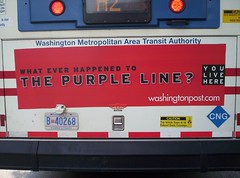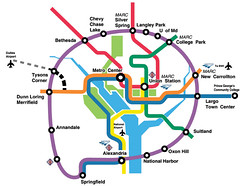I want what she (Virginia's) having...subway transit extension to BWI Airport in Maryland
 Check out the Inner Purple Line website. This shot was taken last summer on Monroe Street NE, approaching Catholic University.
Check out the Inner Purple Line website. This shot was taken last summer on Monroe Street NE, approaching Catholic University.Do you remember the scene from the movie "When Harry Met Sally" with Olympia Dukakis? Today's Post, in "Plan for Metro to BWI Gaining Momentum: Dulles Rail Extension Spurs Md. to Action," reports on increased clamoring-planning for an extension of the WMATA green line subway to BWI Airport.
____________
Correction: Washcycle writes in the comments: "I think you're talking about Estelle Reiner, Carl Reiner's mother who delivers the famous line "I'll have what she's having" - not Olympia Dukakis. That line BTW was voted as the #33 best movie quote of the 20th century by the American Film Institute.
___________________
This isn't a bad thing necessarily, after all, a transit city needs to continually improve and expand transit. But this is about enabling development, because unless planning and development decisions are made in concert with transportation planning, no efficiency results.
This is what I wrote last month (slightly edited), in relation to the refusal of the Virginia Legislature to sign off on Northern Virginia sales tax monies being directed to WMATA:
... a hub and spoke system works fine if and only if land use planning "forces" new residential and commercial development to be planned and developed with mobility in mind. This is also known as compact development.
I don't find commonly used terms like "smart growth" or "transit-oriented development" to be accurate or useful enough to focus on the real problems of deconcentration and decentralization. As terms, SG and TOD are more about keeping the "Growth Machine" happy, mostly the equivalent of slapping paint on a building without priming first, without making any needed fixes to other systems like the flashing and gutters.
I hate the term smart growth, preferring something like "sustainable land use and resource planning." The real "answer" is efficient development, when efficiency is defined as using inputs (land, energy, government resources, etc.) in cost-effective ways that also promote and extend livability rather than to diminish it (i.e., you can reduce the use of government resources by not building parks or libraries, but that hardly makes life better for people).
Efficent development cannot be obtained in a system that continues to deconcentrate and decentralize because you're not able to achieve either the density of housing necessary to support transit or a focused number of destinations (work, shop, play, learn) that can be reached relatively efficiently by transit.
Belmont discusses (in Cities in Full) "monocentricity vs. polycentricity vs. non-centricity" in the chapter "Recentralization of Commerce." He pulls together a variety of arguments that make clear that the kind of "let it all develop on the edge because it's efficient" writings of the pro-suburbanist Joel Garreau (Edge City: Life on the New Frontier, which features Tysons Corner as the idyll) are quite flawed.
About 20 years ago urban ecologist Valerie Haines found that "decreasing spatial separation and the clustering of land uses reduces trip length for nonwork and work trips without producing congestion." UCB professor Robert Cervero has researched this question exhaustively, with the same conclusion.
Belmont points out that "decentralized transit [which is the type of system developed into the WMATA subway system] fails to reduce suburban automobile dependence" because (1) high-density commercial and residential development is not usually created around suburban stations; (2) suburban station-area residents use their cars for non-work trips; and (3) suburban-area workers commute in their cars. (p. 270-1)
By extension this helps confirm a couple of the points made by Sam Smith and reprinted in an earlier blog entry:
-- The subway has removed jobs, businesses, and tourist facilities from the city and has made it possible for ever larger number of suburbanites to exploit DC tax free (thanks to the ban on a commuter tax). DC now has the greatest percentage increase in daytime population owing to commuters of any city in the country but it fails to benefit from this increase commensurate to the costs involved.
-- The subway did not compete with the automobile as promised. In fact, it increased street traffic by attracting new development to which only a portion of the workers came by subway. The rest added to the street traffic.
Decentralization forces households to make more and longer routine trips, mostly by car. Given the very real capacity issues -- one lane of road in one hour can move only 900 automobiles -- there is no solution when the answer is defined around the automobile.
Without urban growth boundaries dedicated to maximizing and achieving efficient mobility, not just preserving open space, I can't see how this system will change (until the oil-gasoline price shock...).
I understand the concerns of Maryland transit advocates like Ben Ross of Action Committee for Transit, because again this proposal is more about enabling development than making a great transit system (a quote in the article discusses how Dulles Airport competes with BWI Airport, so if Dulles has subway access then BWI needs it also to remain competitive). In the article Mr. Ross says:
"We need to take a reality check. All of this is pretty far out," said Ben Ross, president of the Action Committee for Transit, a public transportation advocacy group in Montgomery County. "It's very easy for [Gov. Robert L. Ehrlich Jr. (R)] to say he wants to build something when no construction money will have to be spent until long after he's in office."
Ross said he would support an extension of the Green Line but believes the region's top priority should be the Purple Line, a proposed link between Bethesda and Silver Spring that was shelved by the Ehrlich administration. "If we're serious about transit, we ought to get going on the Purple Line and not starting other studies," he said.
 Sierra Club image.
Sierra Club image.But at the same time, I would argue that there is a tremendous opportunity for linkage and leverage. If the State of Maryland is eager, under a governor relatively opposed to public transit, to build-extend WMATA, jump on it, but connect other WMATA extensions to the same planning and construction process.
Sometimes we advocates get hung up on our thinking and not best how to leverage the activity and initiatives of others, who are often better placed to get things done. (See next blog entry.)
This is a tremendous opportunity that transit advocates need to jump on, NOW!
Index Keywords: transit; growth-machine



0 Comments:
Post a Comment
<< Home